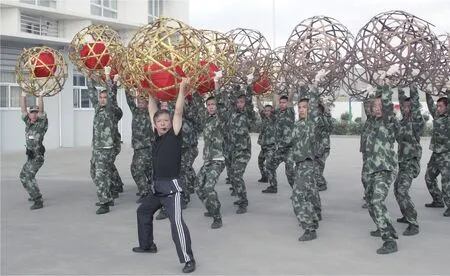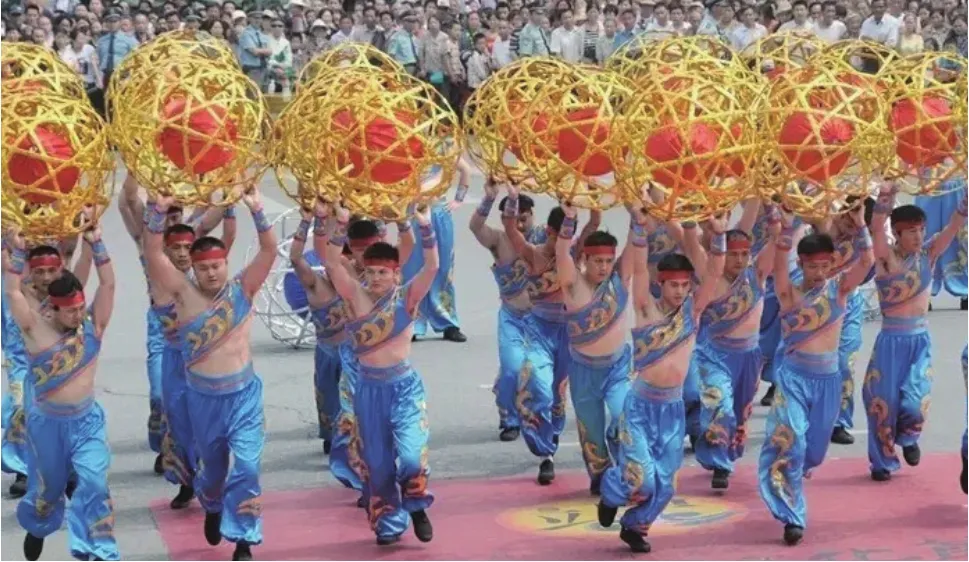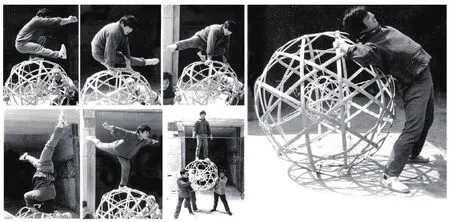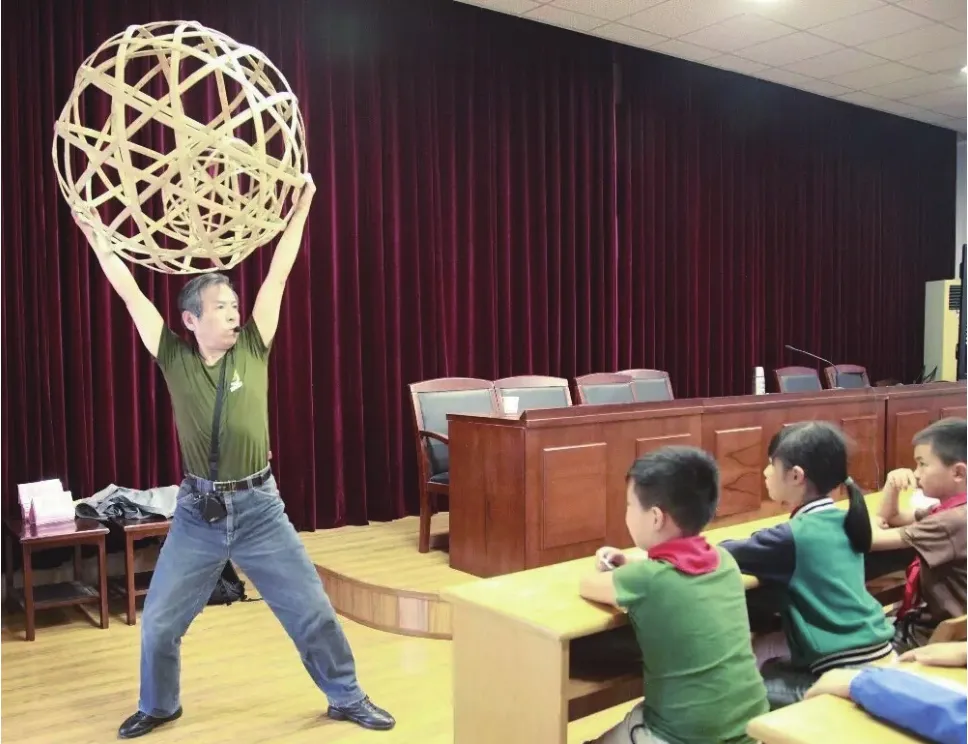海盐滚灯:千旋万转不停息
文/孙 倩

屠尧璋辅导部队官兵跳滚灯舞。吴晓青/摄Tu Yaozhang teaches military personnel to perform the Haiyan Rolling Lamp dance. Photo by Wu Xiaoqing.
灯舞,是中国传统舞蹈中一个非常重要的类别。流传于浙江民间的传统灯舞有鱼灯、龙灯、虾灯、花灯等数十种之多。其中,活跃于嘉兴市海盐县的滚灯舞(俗称“海盐滚灯”)因一改江浙舞蹈柔美温婉的“小家碧玉”气质,呈现出一种钱塘江潮水般排山倒海、大气磅礴的英雄气概而分外引人瞩目,2008年被列入国家级非物质文化遗产名录。
海盐滚灯,又称“英雄灯”,海盐先民们的尚武之风,创造和培育了这朵民间艺术奇葩。据《海盐县志》记载,滚灯源于南宋时期,八百余年传承不绝,曾与古代军队练兵,抗击倭寇、海盗和固坝筑塘等有着千丝万缕的联系,后在民间广泛流传,一般在元宵节灯会上表演,现存九套二十七个动作。传统滚灯道具由12根毛竹条编织而成,在大灯之内套一小灯,小灯之内按照陀螺仪原理装上蜡烛底座,无论如何舞动,蜡烛始终朝上。
成年男子舞的滚灯直径一般90~120厘米,重量30公斤左右。要把如此重的滚灯舞得虎虎生风,没有强健的体魄、不经过一定的训练是几乎不可能的。在几百年的历史变迁中,海盐滚灯一直保持着勇猛雄壮、彰显力量、技巧性强的独特风格。然而,从新中国成立到20世纪80年代的30 年间,海盐滚灯曾一度销声匿迹,直到90年代才又逐渐生龙活虎地走进人们的视野。这“起死回生”的背后,离不开一位古稀老人半生的努力和坚守。他就是海盐滚灯的省级非遗传承人—屠尧璋。

海盐滚灯演出照。海盐县非遗中心/供图Performing the Haiyan Rolling Lamp dance. Photo credit: Haiyan County Intangible Cultural Heritage Center.
今年七十四岁的屠尧璋,从小热爱文体活动,有体操和武术功底。1983年从海盐越剧团转业到县文化馆,从事群众文艺的辅导工作。1984年底,馆领导把收集民间舞蹈的任务交给了他,从此,他便与海盐滚灯结下了近40年的不解之缘。区别于大多数非遗传承人的家族传承,屠尧璋是因为工作原因与海盐滚灯结缘,拜师学艺,师徒传承。更难能可贵的是,他能文能舞,既能跳又能写。无论在编导排练、教学培训,抑或是收集编写、理论研究等,都为海盐滚灯的保护和传承作出了卓越的贡献。弹指一挥间的近大半人生中,有欢笑,也有泪水;有艰辛和执着的努力,也有成功与幸福的收获。
深入挖掘 潜心钻研
20世纪70年代末,曾经活跃在海盐县的一二十支滚灯队消失得无影无踪,会跳滚灯舞的人已是凤毛麟角。1984年底,为了完成上级下达的收集海盐滚灯资料的任务,经多方打听,屠尧璋终于找到了五十多岁的滚灯传人万文观。当他看到融舞蹈、武术、杂技于一体的海盐滚灯,其动作难度非一般人所能表演时,敬畏之心油然而生。为了把动作全部准确地记录下来,他拜万文观为师,将万师父尚能表演的动作一丝不差地全部学会,并就一些动作要领虚心请教、认真领悟。对万师父已无法完成的技巧动作,他凭借多年的武功积累,将它们还原成一个个直观的具体动作,再请万师父审定、纠正。最后,把每个动作进行分解,请摄影师记录下完成该动作的全过程。至今说起这段经历,屠尧璋难掩兴奋:“终于,我把濒临失传的海盐滚灯的九套二十七个动作全部整理出来,为以后绘制图片等留下了一套宝贵的原始资料。”
此后,他又克服困难,解决了滚灯道具内万向蜡烛台的制作和安装问题。然而,要把民间滚灯舞转化成文字、在文章中清晰描述时,对于并非科班出身的屠尧璋来说,却是个不小的考验。为了攻克这一难关,他专程赴上海购买舞蹈、武术书籍,还把馆里所有的舞蹈杂志翻了个遍,把相关动作的描述摘录下来。功夫不负有心人,经过反复修改,他编写的《滚灯》不仅得到了《中国民族民间舞蹈集成》浙江卷编辑部的好评,还被作为范本直送北京总编辑部审定。为此,屠尧璋受到了浙江省文化厅的表彰。
受到鼓舞,更出于对这一古老传统舞蹈的热爱,1987年,屠尧璋撰写了论文《海盐民间“滚灯”舞初探》,并在省民族民间舞蹈研究会上宣读,后发表于当年的《浙江舞蹈》杂志,第一次从美学的角度,对滚灯的形成、精神实质、动律特点等较为详细地进行论述与分析,从此,滚灯舞也如凤凰涅槃般获得了重生。
2008年5月屠尧璋退休,但非遗传承之路却从未停止。一种责任感和使命感始终在他心中呼唤:一定要把老祖宗留下来的优秀传统舞蹈保护好、传承好。为了能给后人留下一些可借鉴的经验教训,屠尧璋忍着心脏支架手术后的病痛,坚持撰写了8000多字的论文《海盐滚灯六十年传承发展的反思》,并参加了长三角滚灯艺术研讨会。其后,又参加了浙江非物质文化遗产代表作丛书《海盐滚灯》的编写。2017年9月,在身体又植入第三枚心脏支架的时候,他依然笔耕不辍,与时间赛跑,针对滚灯舞在传承中存在的新问题、新现象,从社会学和民俗学角度对如何传承发展、如何守正创新进行深入剖析,提出自己的思考和建议。2021年,他的海盐滚灯文化基因解码成果在浙江省“文化基因解码工程”解码成果评审中被评为优秀解码项目。
守正创新 发扬光大
20世纪80年代,在民舞集成编写时期,屠尧璋就清楚地意识到,尽管《滚灯》已经被收入《中国民族民间舞蹈集成》浙江卷和《中国群众文化辞典》,但只有将它搬上舞台,才会有真正的生命力。于是,当1986年嘉兴市舞蹈创作会议召开时,他就提出了滚灯舞的构思,得到了各级领导的肯定,并在当年被定为嘉兴市参加省首届音乐舞蹈节的重点节目。屠尧璋与市群艺馆的舞蹈干部合作担任滚灯舞的编导。最终,该舞获得了编导三等奖、表演二等奖,并引发了人们的广泛关注。

海盐滚灯演出照。陈家龙/摄Performing the Haiyan Rolling Lamp dance. Photo by Chen Jialong.

屠尧璋做海盐滚灯分解动作。海盐县非遗中心/供图Tu Yaozhang performs the breakdown movements of the Haiyan Rolling Lamp dance. Photo credit: Haiyan County Intangible Cultural Heritage Center.
1997年以来,海盐滚灯进入了快速发展期。屠尧璋再次披挂上阵,由他指导的64名男性青年学生组成的滚灯队在嘉兴、海盐多次进行国庆表演,场面震撼。那阳刚洒脱的舞姿、雄健博大的气势惊艳了沿途数万观众。人们从此记住了海盐有一种叫做“滚灯”的传统舞蹈。
海盐滚灯“火”了,屠尧璋也更忙碌了。2000年,重要文化遗产和优秀民间艺术被纳入扶持和保护,加上全国广场文化节的兴起,为群众文化繁荣创造了前所未有的发展契机。海盐滚灯作为具有鲜明地方特色的优秀文化遗产,在一次次演出历练中得以迅速发展壮大:各种形式的演出比赛活动,让上千群众(老、中、青、少、幼)直接加入到滚灯的行列中来,让这一原本来自民间的艺术,又重新回归民间,融入老百姓的生活中。在全县举办的滚灯培训班上,他应邀亲自讲解和教授滚灯舞。培训结束,因此而诞生的滚灯队一下子发展到十多支,演员队伍也扩展到了数百人。
2004年5月,县里把滚灯创意大赛总导演的担子交给了屠尧璋。面对信任,他勇挑重担、大胆创新,将传统与现代的理念融入到整台节目的策划中。职业中学的传统滚灯、武警战士的滚灯龙、实验小学的摩幻滚灯等不同形式、不同风格的滚灯队同时登台亮相,尤其是由他创编的《滚灯龙》,一上场就以强烈的视觉冲击力征服了观众。《滚灯龙》的尝试,对海盐滚灯登上国家级的舞台具有极其重要的意义。2020年10月,巳经七十三岁的屠尧章身体状况欠佳,但为了让滚灯舞在浙江省春晚得以展示,他毫不犹豫地受命重新编排《滚灯龙》。为了把阳光、健美的一面留在排练场上,他忍受病痛而付出的辛苦可想而知。
匠心坚守 薪火相传
时光荏苒,一晃38年过去了。屠尧璋不忘初心,与时俱进,潜心创作,共编导、参编了11个版本的海盐滚灯舞,先后获全国、省、市等不同奖项,其中2004年的两个版本分获第十三届“群星奖”广场舞蹈优秀作品奖、第七届中国艺术节开幕式《风从东海来》金奖。
“莫道桑榆晚,为霞尚满天。”2020年,屠尧璋第四次在全县滚灯培训班上授课。他将自己的全部所学倾囊相授,“中栓腰”“一炷香”“王祥卧冰”……他悉数认真教习、亲身示范。多年来,他直接辅导的学员超过600人次。为了更好地传承海盐滚灯,屠尧璋在积极做好传、帮、带的同时,还有意识地给徒弟留下了传统版本和创新版本的滚灯舞。目前,他带的徒弟中有市级传承人一人、县级传承人3人。无论是在非遗传承基地和村文化礼堂、县图书馆的滚灯讲座上,还是在担任《海盐滚灯》专题片的艺术指导、参与中国舞协的影像采集和央视科教频道影像方志栏目组采访拍摄的现场,他都不遗余力地宣传海盐滚灯。
2022年,在嘉兴市最美“银尚达人”全网投票活动中,年逾古稀的屠尧璋高票当选。谈及海盐滚灯的未来,他信心满满。
Haiyan Rolling Lamp Dance: Rotating and Shining
By Sun Qian

2008年,屠尧璋在海盐县非遗办整理滚灯材料。顾建中/摄Tu Yaozhang works on compiling materials on the Haiyan Rolling Lamp dance in his of fice in 2008. Photo by Gu Jianzhong.
Lamp dance is a major folk dance among the myriad traditional Chinese dance, which is further divided into dozens of different kinds of performances in Zhejiang province, such as fish lamp dance, dragon lamp dance, lobster lamp dance, flower lamp and so on. Among them, the rolling lamp dance (commonly known as the Haiyan Rolling Lamp), popular in Haiyan county of Jiaxing city as its name suggests, has been on the National List of Intangible Cultural Heritage since 2008, thanks to its grand and majestic style, in stark contrast to the generally gentle style of Zhejiang’s dance performances.
According to the local gazetteer, the Haiyan Rolling Lamp originated in the Southern Song dynasty (1127-1279), and has a history of more than 800 years. As a group dance with strong acrobatic and competitive characteristics, the dance, graceful and heroic, requires a lot of skills and many complicated movements in different sequences. Indeed, it was intimately connected with the military in ancient China and is said to be introduced to the public through the troops. Generally performed at the Lantern Festival, the dance comprises twenty-seven movements in nine sets.Traditionally, the lamps are made of 12 bamboo strips, with a bigger lamp containing a smaller lamp, inside which is mounted a candle base according to the principle of gyroscope. Therefore, however the performers move the lamps, the candles inside are always up.
For an adult man, a rolling lamp used in the dance usually has a diameter of 90-120 cm and weighs about 30 kilograms. It is almost impossible to handle such a heavy object and play it handsomely without a strong body and proper training. Over the centuries, the Haiyan Rolling Lamp had maintained its unique style of strength and skill. However, in the 30 years after the founding of People’s Republic of China, the traditional dance fell into obscurity, and it was not until the 1990s that people began to learn more about it. Behind this “return to life” lie the efforts and persistence of Tu Yaozhang, Zhejiang’s provincial inheritor of the Haiyan Rolling Lamp.
Tu, who is 74 years old, has been in love with all sorts of sports activities since childhood, which has helped lay a good foundation for his gymnastics and martial arts skills. In 1983,he began to work at the Haiyan County Cultural Center after quitting his role from the Haiyan Yueju Opera Troupe. As the year 1984 came to a close, he was entrusted with the task of collecting folk dances, and since then, he has been inseparable from Haiyan Rolling Lamp. Unlike most inheritors of intangible cultural heritage, which has been passed down through family lines, Tu’s love story with the Haiyan Rolling Lamp started with his work. What’s more notable is that he can both perform and put his performance to words, which have made outstanding contributions to the protection and inheritance of the Haiyan Rolling Lamp in the past four decades.

为海盐滚灯传承基地天宁小学的学生做培训讲座。林益平/摄Tu Yaozhang shows a move of the Haiyan Rolling Lamp dance during a lecture to a group of students at Tianning Primary School in Haiyan county, Jiaxing city.Photo by Lin Yiping.

2019年,屠尧璋接受中国舞协影像采集组采访。金韦玉/摄Tu Yaozhang receives an interview from the China Dancers Association in 2019.Photo by Jin Weiyu.
By the late 1970s, one or two roller-lanterns, some 20 Haiyan Rolling Lamp troupes once active in the county gradually disappeared without hardly a trace, and it was extremely rare to find people who could perform the dance. At the end of 1984,in order to complete the task of collecting the materials of the Haiyan Rolling Lamp, Tu was eventually able to track down Wan Wenguan, an inheritor of the dance who was in his fifties at the time. When Tu saw the dance movements, which combine martial arts and acrobatics as well, he was awe-struck as it was undoubtedly difficult for any ordinary people to achieve.The record all the movements accurately, he decided to learn the techniques and skills from Master Wan. For those actions that Master Wan could no longer complete, Tu tried to restore them according to Wan’s descriptions and ask him to point out any inaccuracies. In the end, Tu dissected each movement and broke down different components before asking a photographer to record the whole process. Tu still cannot hide his excitement when speaking of the episode: “Finally, I sorted out all the twenty-seven movements in nine sets of the Haiyan Rolling Lamp, leaving behind invaluable materials for later efforts to restore the glory of the dance."
He then painstakingly solved the problem of the manufacturing and installation of the candle tables in the rolling lamps. However, it was quite a test for Tu to turn the folk lantern dance into words and describe it on paper. For this, he went to Shanghai and bought books on dance and martial arts. He read through all the dance magazines in the Haiyan County Cultural Center and made copious notes. After repeated revisions, “Rolling Lamps”, the part he wrote for the Zhejiang volume of “Series of Chinese Folk Dance”, was highly praised.
Encouraged by the success and more importantly by the love for this ancient traditional dance, in 1987, Tu wrote and published a paper on the Haiyan Rolling Lamp,for the first time analyzing from the aesthetic point of view the origins of the rolling lamp,its spiritual essence and rhythmic characteristics. It signified the rebirth of the dance as well.
Since 1997, the Haiyan Rolling Lamp has witnessed rapid development. In that year, under the guidance of Tu Yaozhang,a team of 64 young students performed the rolling lamp dance during the National Day celebrations in Haiyan county and Jiaxing city. The magnificent dancing took the breath of tens of thousands of spectators away and the public started to talk of a traditional dance called “rolling lamp”.
The popularity of the dance made Tu much busier. In 2000, Tu was tasked by the local authorities to develop it into a square dance, which would attract people of all ages and truly be integrated into their everyday life.
Although officially retired in May 2008,Tu has never wavered in his efforts to pass on the dance traditions. He authored an 8,000-word paper, exploring the development of the Haiyan Rolling Lamp in the past 60 years, while still recovering from a stent replacement surgery. Later, he continued contributing to various publications despite undergoing a third stent replacement.In the 38 years since his first encounter with Haiyan Rolling Lamp dance, Tu has won numerous awards at the national,provincial and city levels. Over the years, he has taught over 600 students, which has greatly aided the inheritance of the traditional craft.
In 2022, Tu Yaozhang was voted the most beautiful “Elderly People” in Jiaxing city. Speaking of the future of the Haiyan Rolling Lamp,Tu is full of confidence.

